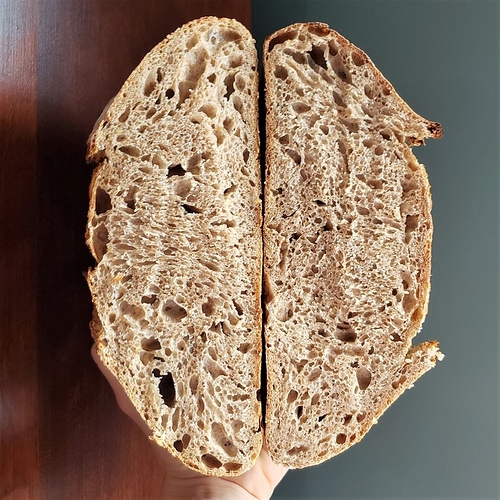Inspired by @wendyk320 in this forum post, I decided to do an experiment where I sifted some of the bran out of a whole grain flour, soaked the bran in boiling water, and add it back during mixing. I wanted to see how this approach compared with simply milling the flour into a bowl and mixing all the ingredients.
I picked warthog wheat because I’ve noticed it tends to mill with visible pieces of bran and I thought it might better show an impact of different treatment. I also enjoy the flavor!
The formula:
54% 215g bread flour
46% 185g whole grain warthog wheat flour
75% 300g water
20% 80g starter
2.1% 1.5 tsp salt
In the “sift and soak” dough, I used a 40 mesh sifter and removed 25g of bran. That’s 13.5% the weight of the warthog flour.
I poured 75g of boiling water on it, and set it aside while my starter ripened.
A few hours later, I added the bran-mush to the other ingredients. There was 158 grams of sifted warthog because I lost a bit to the floor during sifting.
I also made sure to use only 225g water because 75g water was already in with the bran.
At the same time, I also mixed up the all-in dough.
Here are the results inside and out. Sifted and soaked is on the right in both photos.
You can see that the oven spring and score bloom is more pronounced in the sifted and soaked loaf, but the crumb of the two loaves is about the same.
Of note is that fact that the time from mixing the doughs to putting them in the oven was almost 24 hours, due to a lot of cool fermenting. This is long enough that I would’ve thought time might have equalized any difference in softening of bran achieved through the hot water soak. Soaking still seems to have made a difference though.
I think these are interesting results and worth sharing. Maybe others will give the test a try. I’m calling it casual and not-conclusive, though, because the bulk ferment ending up getting staggered, most likely due to position in my cooler. I then had to stagger everything, which is complicated and tends to introduce unintended variables.
I also didn’t do a focused taste test. When linking to @wendyk320 's post above, I was reminded that she notices a texture-mouthfeel difference in her loaves when she sifts and soaks. I would have liked to assess that more thoughtfully. Flavor and texture differences didn’t jump out at me, perhaps because my doughs weren’t 100% whole grain.
Do you sift and soak? All whole grain wheats? Only some varieties?





 I tried using a plastic bag too as per the recommendation of some in these forums. That helped.
I tried using a plastic bag too as per the recommendation of some in these forums. That helped.